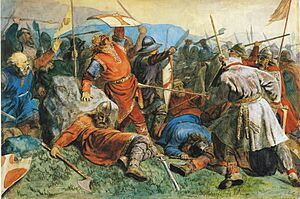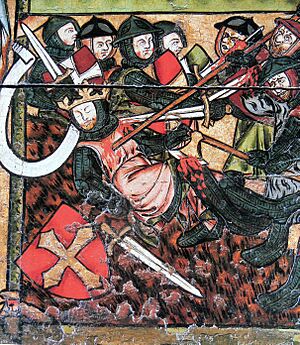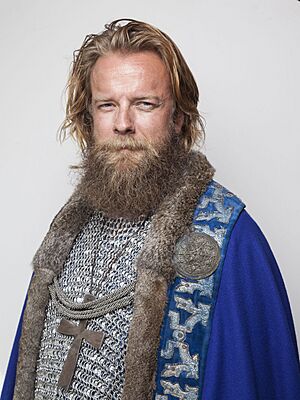Battle of Stiklestad facts for kids
Quick facts for kids Battle of Stiklestad |
|||||||
|---|---|---|---|---|---|---|---|
 The Death of Olaf II at the Battle of Stiklestad |
|||||||
|
|||||||
| Belligerents | |||||||
|
Olaf Haraldsson's hird and allies.
|
The "Farmer Army" composed of Rival jarls, chieftains, villagers and others loyal to Cnut the Great. | ||||||
| Commanders and leaders | |||||||
| Olaf II of Norway † Dagr Hringsson Harald Hardrada (WIA) |
Kálfr Árnason Þórir hundr Hárek of Tjøtta Thorir Hund |
||||||
| Strength | |||||||
| ca. 6,600 | ca. 14,400 | ||||||
| Casualties and losses | |||||||
| ca. 4,200 | ca. 4,600 | ||||||
The Battle of Stiklestad is one of the most famous battles in Norway's history. It happened in 1030. During this battle, King Olaf II of Norway was killed. He was later declared a saint by the Roman Catholic Church in 1164.
Olaf's younger half-brother, Harald Hardrada, was also there. Harald was only fifteen years old at the time. He later became King of Norway in 1047. Harald died in 1066 during an invasion of England at the Battle of Stamford Bridge.
Some historians question if the battle truly happened as described. Early writings say the king was murdered. For example, the Anglo Saxon Chronicle from 1030 says Olaf was killed by his own people. Other writers like Adam of Bremen and Florence of Worcester also said he died in an ambush.
After Olaf became a saint, people felt he could not have died in such a way. The story of the Battle of Stiklestad, as many know it today, grew over 200 years. It was believed that a saint like Olaf must have died in a big battle for Christianity.
Contents
Why the Battle of Stiklestad Happened
In the 800s, Norway was divided into many small kingdoms. King Harald Fairhair united these lands by the end of the century. He did this mainly through a strong alliance with Hákon Grjótgarðsson.
After Harald's death, the country split again. Powerful leaders called jarls of Lade and Harald's family fought for control. Religion also played a part. Some of Harald's descendants tried to convert the Norwegians to Christianity.
In 1000, the Lade jarls took control of Norway. They had the support of the Danish King Sweyn Forkbeard. But in 1015, Olaf Haraldsson returned from his Viking travels. He was chosen as King of Norway. He won the Battle of Nesjar in 1016 against the Lade jarls.
Olaf became king because the Danish king, Cnut the Great, was busy fighting in England. In 1028, Cnut teamed up with the Lade jarls. This forced Olaf to leave Norway and go to Kievan Rus'.
In 1029, the last Lade jarl, Haakon Sigurdsson, drowned. Olaf then planned to take back his throne. The Swedish king Anund Jacob helped Olaf. He wanted to weaken Cnut's power. He gave Olaf 400 men and guides to lead them into Norway.
The Battle of Stiklestad: What Happened?
Stories say Olaf traveled with his 3,600 men through Sweden. They crossed the mountains into the Verdal valley. This valley is about 80 kilometers (50 miles) north of Trondheim. Olaf and his men arrived at Stiklestad, a farm in the valley.
This is where the Battle of Stiklestad supposedly took place. The famous writer Snorri Sturluson described it in his book Heimskringla. He wrote this about 200 years after the battle.
At Stiklestad, Olaf met an army led by Hárek of Tjøtta, Thorir Hund, and Kálfr Árnason. Kálfr Árnason had previously served Olaf. Snorri says the opposing army was made of "farmers." It had about 14,400 men.
Olaf's men shouted, "Forward! Men of Christ, men of the cross, men of the king!" The other army shouted, "Forward! Farmers!"

According to Snorri, King Olaf received three serious wounds. One was in his knee, another in his neck. The final, deadly blow was a spear thrust into his stomach. This happened while he was leaning against a large stone.
Saga stories say Thorir Hund, Kálfr Árnason, and Torstein Knarresmed gave Olaf his fatal wounds. Thorir Hund used a spear that had killed his nephew. This event had caused a feud between the king and Thorir.
During the battle, King Olaf almost killed Thorir Hund with a war hammer. But Torstein Knarresmed stepped in and wounded Olaf above his left knee. Soon after, Thorir Hund thrust his spear into the king's stomach. Then Kálfr Árnason struck the king's throat with his sword. Torstein Knarresmed was later killed.
The king's body was secretly taken away. It was buried in the sandy banks of the Nidelva River. This river is south of Trondheim.
After the Battle: Olaf's Legacy
The year after the battle, Olaf's grave was opened. According to Snorri, his body had not decayed. His hair and nails had even grown. His coffin was then moved to St. Clement's Church in Trondheim.
Bishop Grimketel, whom Olaf had brought from England, started the process of making Olaf a saint. This happened on August 3. Stiklestad Church was built on the spot where St. Olaf died. The stone he leaned against is supposedly still inside the church's altar.
One hundred years later, Nidaros Cathedral was built in Trondheim. It was on the site of Olaf's first burial place. Olaf's body was moved there. It was placed in a silver container called a reliquary behind the main altar. This reliquary looked like a tiny church. It even had dragon heads like those seen on Norwegian stave churches.
In the 1500s, during the Protestant Reformation, Olaf's body was removed. The reliquary was melted down for coins by the Dano-Norwegian king. Olaf's remains were reburied somewhere in Nidaros Cathedral. Exactly where is still a mystery.
Later, Queen Josephine of Leuchtenberg of Norway and Sweden asked for a bone relic of St. Olaf. King Frederick VII of Denmark gave it to her. She then gave it to St. Olaf's Cathedral in Oslo in 1862.
Understanding the Battle Today
Snorri's descriptions of battles in Heimskringla are exciting to read. However, they might be exaggerated for dramatic effect.
Olaf's army was likely not very large. He was only with his most loyal followers in Gardarike. It would have been hard to find many new soldiers in Sweden. The valleys he traveled through were also not very populated. So, Olaf's army was probably a mix of different groups. Some stories even say local robber gangs joined him.
It is still a mystery why Olaf chose to travel through Trøndelag. This area was politically against him. He could have tried to gather support from his family in Eastern Norway. Maybe he hoped to win over the farmers of Trøndelag.
The opposing army, made of local nobles and farmers, probably did not have much time to gather a huge force. They would have had to act quickly when they heard Olaf was near. This suggests a smaller, quickly organized group of men. It does not sound like a large army of 10,000 men.
Powerful local nobles, like Einar Thambarskelfir, were mostly absent from both sides. Also, a battle with nearly 20,000 men should leave many archaeological findings. But at Stiklestad, such findings are rare. This is common in Norway because the rocky soil makes it hard to find things. The exact location of the battle is still uncertain.
Olaf's importance in Norwegian history grew after his death. The nobles and rich farmers thought things would improve without Olaf. But the rule of Cnut's son, Svein, was very harsh. The church, which usually supported Olaf, also faced pressure.
So, Olaf's status as a martyr grew. This helped common people rebel against the harsh Danish rule. Stories of Olaf's heroic last stand helped build a sense of national identity in Norway. The Viking warrior spirit was still strong.
Snorri even wrote that a solar eclipse happened on the day of the battle. He described it as a "blooded red sun." This was seen as a bad sign. However, the eclipse actually happened on August 31, not July 29, the traditional battle date.
Olaf was a stubborn and sometimes harsh ruler. Many historians agree he could be brutal. But, ironically, he became Norway's patron saint. His sainthood helped unite the country. It also completed the conversion of Norway to Christianity, which Olaf had worked hard for.
While he caused divisions in life, in death Olaf became the "eternal king of Norway." He had a unifying power that no foreign ruler could undo. Cnut ruled Norway for five years after the battle through his son Svein. But when Olaf's son Magnus claimed the throne, Cnut had to give in. This led to a century of growth and prosperity for Norway.
Stiklestad's Importance Today
The Stiklestad National Cultural Center was created in 1995. It is located in Verdal. The Olavsstøtta is a monument there. It was put up in 1807 to remember the Battle of Stiklestad. It is one of Norway's oldest public monuments.
In 1901, the poet Per Sivle wrote a poem called Tord Foleson. It was about King Olaf's flag-bearer in the battle. Foleson managed to plant the banner before he died. It stayed standing throughout the battle, even after the king fell. People kept it standing for centuries. A memorial stands at the site today.
The most famous line from the poem is, "The symbol stands, even when the man falls." This line is carved on a memorial in Stalheim, Norway. It is also on a wall at the Bergen-Belsen concentration camp memorial site.

The Saint Olav Drama is an outdoor play performed every July in Stiklestad. In 1954, the farm owner allowed a play about the battle to be performed on his land. The play was written by Olav Gullvåg. It has been performed every year since 1954. People travel to Stiklestad each year to watch it. It is now the largest outdoor theater in Scandinavia.
See also
- Olavsfestival
- Olavinlinna
- Ólavsøka
- Olsok
- Legendary Saga of St. Olaf
- Separate Saga of St. Olaf
Other sources
- Bagge, Sverre Cross and Scepter (Princeton University Press. 2014) ISBN: 978-0691161501
- Bagge, Sverre From Viking Stronghold to Christian Kingdom (Museum Tusculanum Press. 2010) ISBN: 978-8763507912
- Henriksen, Vera St Olav of Norway: King, saint and enigma (TANO. 1985) ISBN: 978-8251820554
- Myklebus, Morten Olaf Viking & Saint (Norwegian Council for Cultural Affairs, 1997) ISBN: 978-82-7876-004-8
- Winroth, Anders The Conversion of Scandinavia (Yale University Press. 2012) ISBN: 978-0300205534




